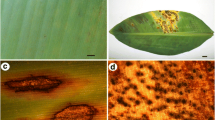Abstract
Light microscopy of the prepenetration process of Phyllosticta musarum, the banana freckle disease causal agent, on banana leaf was conducted. Germination of conidia started within 2–3 h after inoculation (AI) in a film of water at 25°C. More than 50 and 90% of conidia germinated at 12 and 72 h AI at 25°C, respectively. The germination of a conidium usually produced one germ tube, and occasionally two germ tubes, which were borne at the side of the conidium. However, only one germ tube developed into a mature appressorium. Appressoria were dark brown in colour and had different shapes. Most of them were round or slightly lobed. Appressorium formation initiated at 6 h AI, and the appressorial formation rate reached more than 50 and 80% at 24 and 48 h AI, respectively. A reddish-brown necrosis of host cells appeared under the appressoria as they were forming and was seen at 120 h AI. Most appressoria were formed in the grooves between adjacent epidermis cells. The pathogen seems to penetrate directly through the epidermal cuticle layer of the host by forming appressoria and infection pegs.
Similar content being viewed by others
References
Chuang TY (1984) Ecological study of banana freckle caused by Phyllosticta musarum. Plant Protection Bulletin 26, 335–345. [In Chinese].
Hoffman LE, Wilcox WF, Gadoury DM, Seem RC (2002) The influence of grape berry age on susceptibility to Guignardia bidwellii and its incubation period length. Phytopathology 92, 1068–1076. doi: 10.1094/PHYTO.2002.92.10.1068
Jones D (2000) ‘Diseases of banana, abacá and enset.’ (CAB Publishing: Wallingford)
Khan A, Hsiang T (2003) The infection process of Colletotrichum graminicola and relative aggressiveness on four turfgrass species. Canadian Journal of Microbiology 49, 433–442. doi: 10.1139/w03-059
Kiely TB (1949) Preliminary studies on Guignardia citricarpa n.sp.: the ascigenous stage of Phoma citricarpa McAlp. and its relation to black spot of citrus. Proceedings of the Linnean Society of New South Wales 73, 249–292.
Lacy ML (1994) Influence of wetness periods on infection of celery by Septoria apiicola and use in timing sprays for control. Plant Disease 78, 975–979.
McOnie KC (1964) Speckled blotch of citrus induced by the citrus black spot pathogen, Guignardia citricarpa. Phytopathology 54, 1488–1489.
Meredith D (1968) Freckle disease of banana in Hawaii caused by Phyllostictina musarum (Cke) Petr. The Annals of Applied Biology 62, 328–340.
Stover RH (1972) ‘Banana, plantain and obaca diseases.’ (Commonwealth Mycological Institute: Kew)
Tsai YP, Chen HP, Liu SM (1989) Freckle disease in banana and its control. Taiwan Agriculture Bimonthly 25, 33–38. [In Chinese].
van der Aa HA (1973) Studies in Phyllosticta I. Studies in Mycology 5, 1–110.
Zeng Z, Liu G, Lin Z (2003) Experimental control of banana scab disease using different fungicides. China Fruits 1, 32–34. [In Chinese].
Author information
Authors and Affiliations
Corresponding author
Rights and permissions
About this article
Cite this article
Pu, J., Xie, Y., Zhang, X. et al. Preinfection behaviour of Phyllosticta musarum on banana leaves. Australasian Plant Pathology 37, 60–64 (2008). https://doi.org/10.1071/AP07079
Received:
Accepted:
Issue Date:
DOI: https://doi.org/10.1071/AP07079




